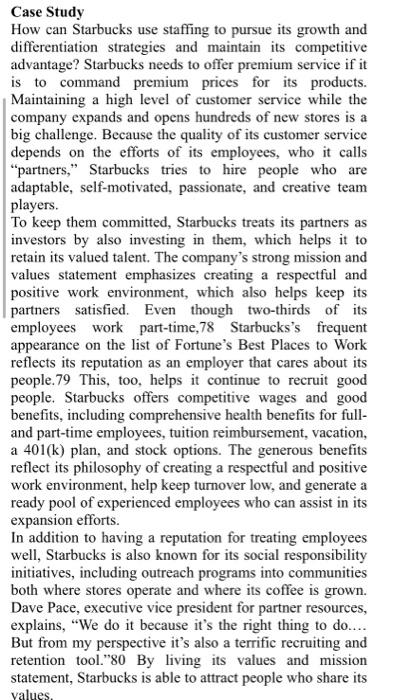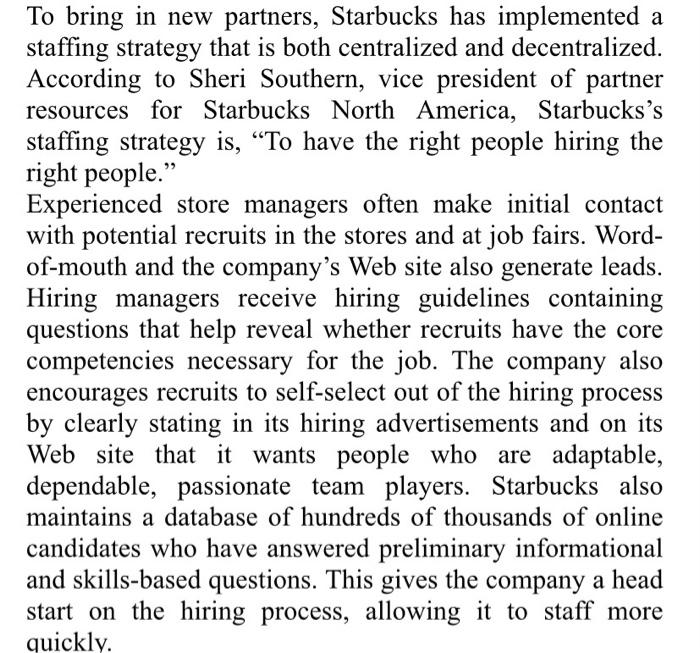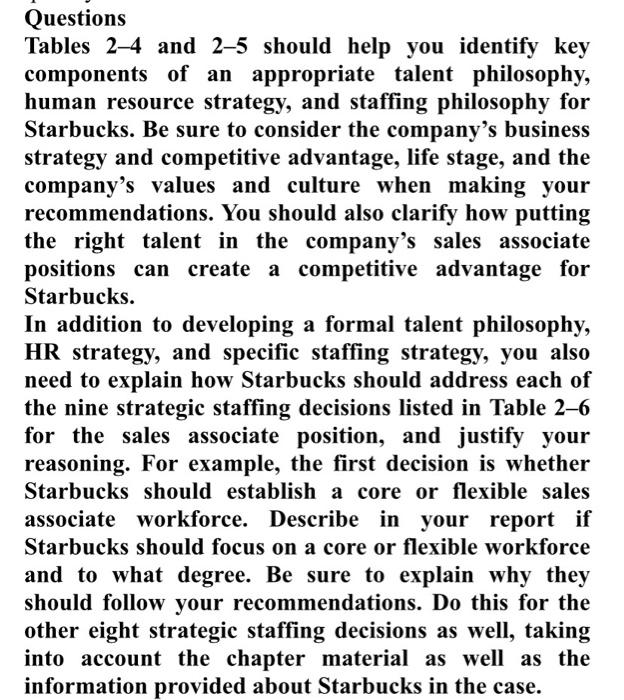Case Study How can Starbucks use staffing to pursue its growth and differentiation strategies and maintain its competitive advantage? Starbucks needs to offer premium service if it is to command premium prices for its products. Maintaining a high level of customer service while the company expands and opens hundreds of new stores is a big challenge. Because the quality of its customer service depends on the efforts of its employees, who it calls "partners," Starbucks tries to hire people who are adaptable, self-motivated, passionate, and creative team players. To keep them committed, Starbucks treats its partners as investors by also investing in them, which helps it to retain its valued talent. The company's strong mission and values statement emphasizes creating a respectful and positive work environment, which also helps keep its partners satisfied. Even though two-thirds of its employees work part-time,78 Starbucks's frequent appearance on the list of Fortune's Best Places to Work reflects its reputation as an employer that cares about its people.79 This, too, helps it continue to recruit good people. Starbucks offers competitive wages and good benefits, including comprehensive health benefits for fulland part-time employees, tuition reimbursement, vacation, a 401(k) plan, and stock options. The generous benefits reflect its philosophy of creating a respectful and positive work environment, help keep turnover low, and generate a ready pool of experienced employees who can assist in its expansion efforts. In addition to having a reputation for treating employees well, Starbucks is also known for its social responsibility initiatives, including outreach programs into communities both where stores operate and where its coffee is grown. Dave Pace, executive vice president for partner resources, explains, "We do it because it's the right thing to do.... But from my perspective it's also a terrific recruiting and retention tool." 80 By living its values and mission statement, Starbucks is able to attract people who share its values. To bring in new partners, Starbucks has implemented a staffing strategy that is both centralized and decentralized. According to Sheri Southern, vice president of partner resources for Starbucks North America, Starbucks's staffing strategy is, "To have the right people hiring the right people." Experienced store managers often make initial contact with potential recruits in the stores and at job fairs. Wordof-mouth and the company's Web site also generate leads. Hiring managers receive hiring guidelines containing questions that help reveal whether recruits have the core competencies necessary for the job. The company also encourages recruits to self-select out of the hiring process by clearly stating in its hiring advertisements and on its Web site that it wants people who are adaptable, dependable, passionate team players. Starbucks also maintains a database of hundreds of thousands of online candidates who have answered preliminary informational and skills-based questions. This gives the company a head start on the hiring process, allowing it to staff more quickly. Questions Tables 2-4 and 2-5 should help you identify key components of an appropriate talent philosophy, human resource strategy, and staffing philosophy for Starbucks. Be sure to consider the company's business strategy and competitive advantage, life stage, and the company's values and culture when making your recommendations. You should also clarify how putting the right talent in the company's sales associate positions can create a competitive advantage for Starbucks. In addition to developing a formal talent philosophy, HR strategy, and specific staffing strategy, you also need to explain how Starbucks should address each of the nine strategic staffing decisions listed in Table 2-6 for the sales associate position, and justify your reasoning. For example, the first decision is whether Starbucks should establish a core or flexible sales associate workforce. Describe in your report if Starbucks should focus on a core or flexible workforce and to what degree. Be sure to explain why they should follow your recommendations. Do this for the other eight strategic staffing decisions as well, taking into account the chapter material as well as the information provided about Starbucks in the case. TABLE 2-4 Questions Addressed by an Organization's Talent Philosophy 1. Do we want people to contribute to the company over long-temt caveen or do we want to focia on filing wacancies in the short serm? 2. Do we value the ideas and contributions of people with diverse ideas and perspectives? 3. Do we see cur eriployoes as assets to be managed or employoes an irvestors who choose where to allocate their time and whilors? 4. What are our ethical princples when it comes to our employees? TABLE 2.6 Nine Elements of the Staffing Strategy 1. Do we want a cone or fleskle workforce? 2. Do we prefer to hire internally or enternally? 3. Do we want to hice for or train and develop needed shills? 4. Do we wint to replace or netain our talent? 5. What levels of which abils do we need where? 6. Will we stall proactively or reactively? 7. Which jobs thould we focus on? 8. Is stafling treated as an itveitment or a coor? 9. Will stating be centralued oe decentralized










